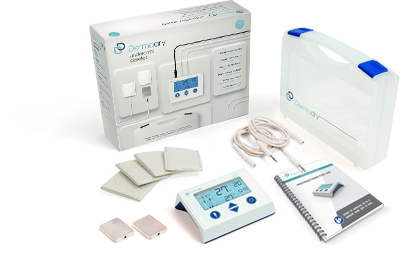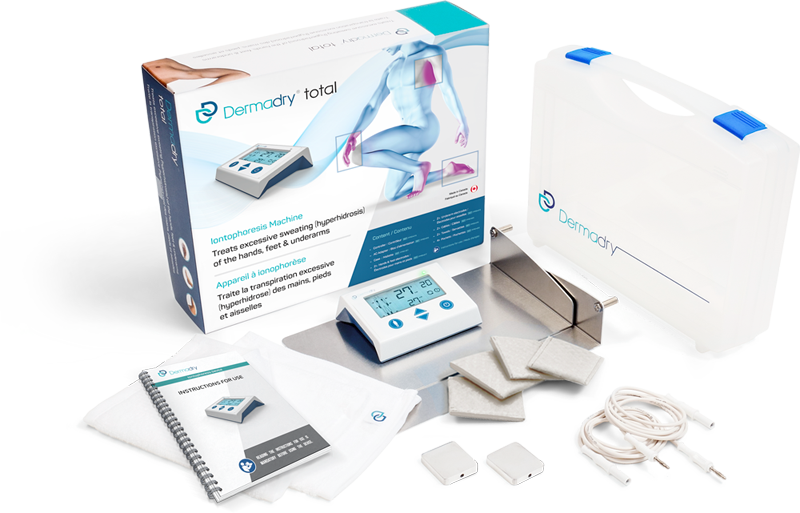The Risks Associated with Sweaty Feet
Dermadry Team
Today is International Podiatry Day, presented by the International Federation of Podiatrists (IFP)! This is a global awareness campaign aimed at spreading the word about the importance of foot health.
Plantar hyperhidrosis (excessive sweating of the feet) is a common medical condition that affects millions worldwide. In addition to leading to discomfort caused by dampness in shoes and socks, it can also lead to irritation and infections of the feet. In fact, excessive sweating is the leading cause of ingrown toenails and athlete's foot.
To learn more about plantar hyperhidrosis, as well as its links to other foot diseases, read on!
Why Do My Feet Sweat So Much? Plantar Hyperhidrosis
Primary plantar hyperhidrosis, also known as excessive sweating of the feet, is a medical condition with no known cause. Those affected will experience 4-5 times more sweating than the average person, and in excess of what is needed for body temperature regulation. The feet are one of the areas most commonly affected.
It is estimated that approximately 5% of the global population (1 in 20 people) suffer from excessive sweating. Plantar hyperhidrosis is a benign condition, but it can cause discomfort and constant dampness in shoes. This can lead to infections and diseases affecting the feet. Additionally, sufferers also cite it as a major nuisance that impacts their footwear selection and choice, often having to pay a premium for special moisture-wicking socks and breathable shoes, and having to replace shoes more often.
Excessive Sweating is the Leading Cause of Ingrown Toenails
Ingrown toenails are one of the most common diseases affecting the feet. The condition affects over 20% of podiatry patients, and can result in infections, and inflammation. Ingrown toenails have many causes, such as improper trimming, trauma to the nail, genetic predisposition, hyperhidrosis, and poor foot hygiene.
The most common cause of ingrown toenails is plantar (foot) hyperhidrosis. According to a recent clinical study, over 58% of patients suffering from ingrown toenails also suffered from hyperhidrosis of the feet.
Hyperhidrosis is a medical condition characterized by excessive sweating that most commonly affects the hands, feet, and underarms. Those who suffer from the condition are more susceptible to developing ingrown toenails, as toenails can more easily penetrate surrounding tissue when it is moist and soft. Those suffering from plantar hyperhidrosis will regularly sweat through socks and shoes, regardless of external factors. Therefore, unless the patient is constantly changing footwear and drying off, which can be inconvenient and nearly impossible in certain situations, their feet remain moist all day. This makes them more likely to develop ingrown toenails, among other infections and conditions affecting the foot, through no fault of their own.
If you suffer from recurring cases of ingrown toenails, and you also suffer from excessive sweating, then there is a good chance the two are linked. Iontophoresis is one of the safest, most effective, and long-lasting ways to treat hyperhidrosis.
The Link Between Plantar Hyperhidrosis and Athlete's Foot
Athlete’s Foot, also known as Tinea Pedis, is the most common type of fungal skin infection. It is a contagious infection that is caused by fungi called dermatophytes, which can be spread by direct or indirect contact with the infected skin. Once these fungi have contaminated the skin, they thrive in similar moist conditions, such as closed, damp shoes.
Sweaty feet are consistently ranked as one of the top risk factors for athlete’s foot and can even be the cause of recurring cases of the condition. In fact, a 2001 study found that hyperhidrosis, along with hot, humid climates and sporting activities, were the primary risk factors associated with athlete’s foot.
Many clinical studies have been done on the link between plantar hyperhidrosis and athlete's foot. A study found that the overall risk of any skin (cutaneous) infection was increased in sites with hyperhidrosis. There is also an increased risk of fungal infections, with a particularly increased risk for dermatophyte infections (as is the case with athlete's foot). In another study, researchers noted a 3.5-fold increased risk for patients with athlete’s foot to have hyperhidrosis. This is caused by the softening of the skin due to excessive sweating. In the case of plantar hyperhidrosis, excessive sweat can soften the skin and decrease the defense against fungal infection, and can also weaken toenails, leading to ingrown toenails.
Successfully curing the condition will often require an individual to change their habits regarding foot care, which can include properly drying off feet, wearing moisture-wicking socks, and looser breathable shoes. This is easier said than done for those who suffer from excessive foot sweating, also known as plantar hyperhidrosis, who have uncontrollable and spontaneous excessive sweating.
As hyperhidrosis is one of the primary risks associated with the development of athlete’s foot If you suffer from sweaty feet, then a great way to prevent future recurring cases is to treat the root of the problem (plantar hyperhidrosis) with iontophoresis.
How to Treat Sweaty Feet (Iontophoresis)
As hyperhidrosis is one of the primary risks associated with the development of athlete’s foot and ingrown toenails, then you can eliminate the risk by treating the root of the problem.
Antiperspirants, injections, and medications are not always ideal ways to treat hyperhidrosis of the feet, as the feet are very sensitive (can make injections very painful) and antiperspirant application is tricky, can leave unwanted residue behind, and is generally ineffective. Medications are systemic and cannot target treat excessive sweating of the feet, and cause full-body side-effects that outweigh it's advantages. Iontophoresis is an all-natural, non-invasive, drug-free, and needle-free treatment option that can provide up to 6 weeks of dryness.
Tap water iontophoresis for the treatment of palmar (hand) and plantar (foot) hyperhidrosis can be traced back at least as far back as the 1940s. Since its introduction, it has undergone significant technological advancements and developments and now with the help of devices like Dermadry, treatment can be done at home.
This technology works by directing a mild current through the skin, neutralizing the connection between the nerves and sweat glands. Iontophoresis treatment is done with a medical device, which is plugged into a power source that produces an electrical current that travels via tap water (the conductor), reaching the conductive electrodes that are submerged in water and touching the skin. A protective barrier, such as a towel or sponge is used to make treatment more comfortable by protecting the skin from coming into direct contact with the electrodes. In nearly all cases, this dramatically reduces excessive sweating.
In addition to potentially preventing athlete’s foot and reducing your risk for recurring ingrown toenails, you will also enjoy day-long comfort in the footwear of your choice. No more hazardous slipping in your shoes, or discomfort in close-toed shoes. Rather, with the proper treatment you'll have the freedom to wear any type of shoe you want.
Dermadry's Anti-Sweat Device
Dermadry is an FDA cleared iontophoresis device that treats excessive sweating (hyperhidrosis) of the hands, feet, and underarms. Our anti-sweat device has a 98.3% success rate, and a podiatrist-recommended solution for sweaty feet.
Dermadry is committed to educating the public on hyperhidrosis. We are proud that our anti-sweat device has the seal of approval from the Canadian Podiatric Medical Association (CPMA)! Additionally, we are proud to have attended last year's 2019 IFP World Congress of Podiatry to raise awareness of plantar hyperhidrosis and iontophoresis as a non-invasive, drug-free, and needle-free way to treat the condition. We are continuously working with podiatrists from all over the world to make our solution for sweaty feet more widely known and available to all.
Discover our anti-sweat device range below.























